Get free scan and check if your device is infected.
Remove it nowTo use full-featured product, you have to purchase a license for Combo Cleaner. Seven days free trial available. Combo Cleaner is owned and operated by RCS LT, the parent company of PCRisk.com.
What is Arrival Notice Email Virus?
"Arrival Notice Email Virus" is another spam email campaign that proliferates high-risk malware called Remcos. Developers send thousands of emails stating that a DHL shipment has been delivered and encourages users to open an attachment for more information. Once opened, the malicious attachment stealthily downloads and installs Remcos.
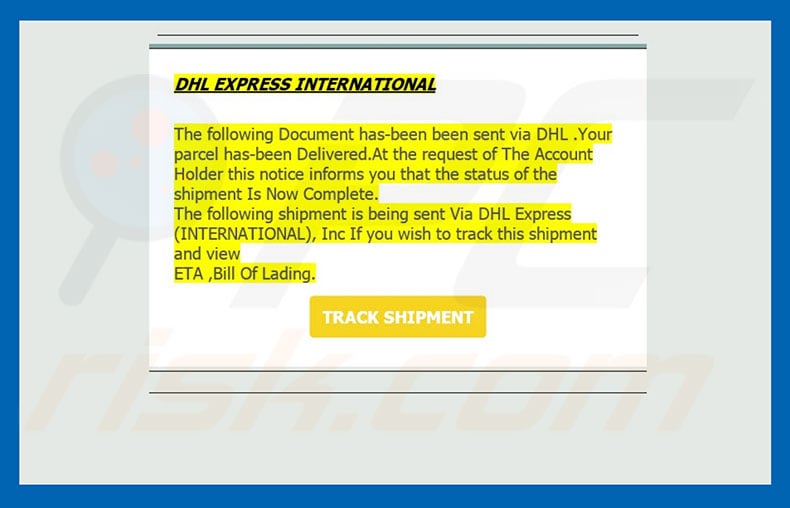
The email contains a message stating that a package has been delivered and the user must open an attached Microsoft Word for more details. This is a scam and DHL has nothing to do with it. Cyber criminals often claim to be employees of legitimate companies or governmental agencies.
This helps them to give the impression of legitimacy - it is much simpler to trick users into opening files that are received from familiar names. Remcos is a Remote Administration Tool (RAT). It allows cyber criminals to control the hijacked computer remotely. In this way, they can misuse the infected machine to perform various malicious tasks.
Be aware that each aspiring cyber criminal can purchase the executable of Remcos RAT from developers. Therefore, we cannot specify exactly which actions will be performed - each criminal behaves differently, however, most aim to generate as much revenue as possible.
Therefore, Remcos RAT might be used to infect the system with other malware that tracks web browsing activity and records sensitive information (keystrokes, saved logins/passwords, etc.) Cyber criminals might thus gain access to personal accounts (PayPal, social networks, banks, etc.) Therefore, having a RAT such as Remcos installed on your computer can result in serious privacy issues, significant financial loss, and high-risk computer infections.
If you have recently opened attachments distributed using the "Arrival Notice Email Virus" spam campaign, immediately scan the system with a reputable anti-virus/anti-spyware suite and eliminate all detected threats.
| Name | Arrival Notice spam |
| Threat Type | Trojan, Password stealing virus, Banking malware, Spyware |
| Symptoms | Trojans are designed to stealthily infiltrate victim's computer and remain silent thus no particular symptoms are clearly visible on an infected machine. |
| Distribution methods | Infected email attachments, malicious online advertisements, social engineering, software cracks. |
| Damage | Stolen banking information, passwords, identity theft, victim's computer added to a botnet. |
| Malware Removal (Windows) |
To eliminate possible malware infections, scan your computer with legitimate antivirus software. Our security researchers recommend using Combo Cleaner. Download Combo CleanerTo use full-featured product, you have to purchase a license for Combo Cleaner. 7 days free trial available. Combo Cleaner is owned and operated by RCS LT, the parent company of PCRisk.com. |
There are dozens of spam email campaigns that share similarities with "Arrival Notice Email Virus" including, for example, JPMorgan Chase Email Virus, Wells Fargo Email Virus, DocuSign Email Virus, etc.
Unlike "Arrival Notice Email Virus", these campaigns do not distribute Remote Administration Tools - they distribute trojan-type viruses (e.g., Adwind, FormBook, Emotet, etc.) or ransomware. This does not indicate that these spam campaigns are less dangerous, since all distributed viruses pose a significant threat to your privacy and computer safety.
How did Arrival Notice Email Virus infect my computer?
"Arrival Notice Email Virus" distributes malicious MS Office documents. Once opened, these files request macro commands to be enabled, otherwise the content will not be displayed properly. In fact, by enabling macros, users inadvertently grant attachments permission to execute commands that infiltrate Remcos RAT.
Although this malware distribution method is simple and effective, it is not flawless. Malicious attachments are unable to execute commands if the user opens them using any software other than Microsoft Word. In addition, Remcos RAT only works on Microsoft Windows Operating System and thus users of other platforms are safe.
How to avoid installation of malware?
Lack of knowledge and careless behavior are the main reasons for computer infections. The key to safety is caution. Therefore, pay close attention when browsing the Internet. Carefully analyze all received email attachments.
If the file seems irrelevant or has been received from a suspicious/unrecognizable email address, it should never be opened - these emails should be deleted immediately without reading. In addition, it is very important to have a reputable anti-virus/anti-spyware suite installed and running.
Be aware that the more recent versions (2010 and above) of MS Office open newly-downloaded documents in "Protected View" mode. This prevents malicious files from infecting the system. Therefore, we strongly advise you to avoid using old versions of Microsoft Office.
If you have already opened "Arrival Notice Email Virus" attachment, we recommend running a scan with Combo Cleaner Antivirus for Windows to automatically eliminate infiltrated malware.
Text presented in the "Arrival Notice Email Virus" email message:
Subject: Arrival Notice For BL – DATE / Vessel – DHL ATLANTIC
DHL EXPRESS INTERNATIONAL
The following Document has-been been sent via DHL .Your parcel has-been Delivered.At the request of The Account Holder this notice informs you that the status of the shipment Is Now Complete.
The following shipment is being sent Via DHL Express (INTERNATIONAL), Inc If you wish to track this shipment and view
ETA ,Bill Of Lading.
TRACK SHIPMENT
Malicious attachments distributed via "Arrival Notice Email Virus" spam campaign:
Example of DHL Arrival Notice spam email used to promote a phishing website (fake DHL parcel tracking site):
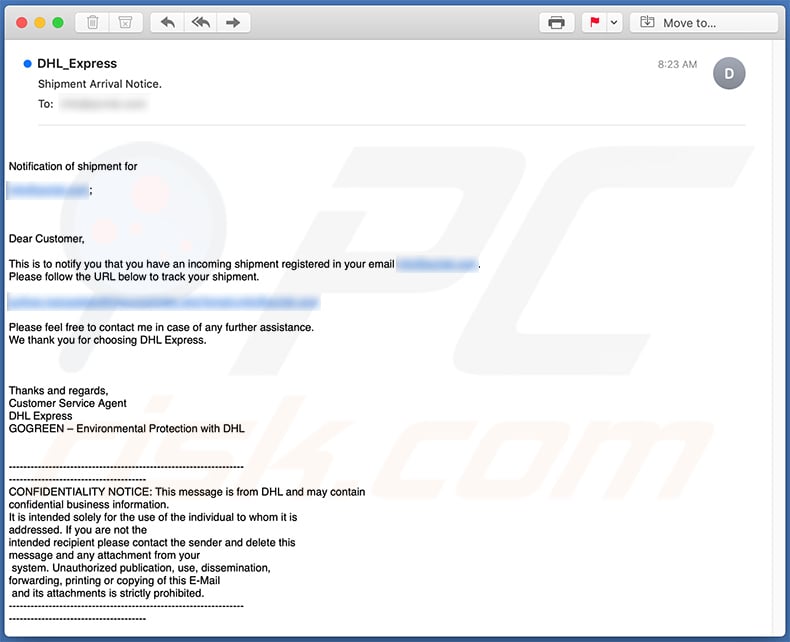
Text presented within:
Subject: Shipment Arrival Notice.
Notification of shipment for
********;
Dear Customer,
This is to notify you that you have an incoming shipment registered in your email ********.
Please follow the URL below to track your shipment.-
Please feel free to contact me in case of any further assistance.
We thank you for choosing DHL Express.
Thanks and regards,
Customer Service Agent
DHL Express
GOGREEN – Environmental Protection with DHL
-----------------------------------------------------------------
--------------------------------------
CONFIDENTIALITY NOTICE: This message is from DHL and may contain
confidential business information.
It is intended solely for the use of the individual to whom it is
addressed. If you are not the
intended recipient please contact the sender and delete this
message and any attachment from your
system. Unauthorized publication, use, dissemination,
forwarding, printing or copying of this E-Mail
and its attachments is strictly prohibited.
-----------------------------------------------------------------
--------------------------------------
Screenshot of the promoted phishing website:
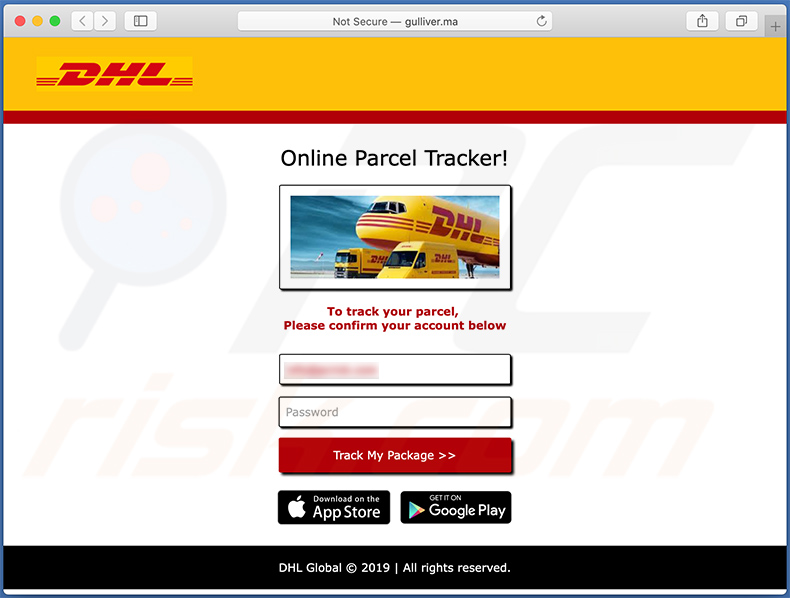
Yet another example of arrival notice-themed spam email spreading malware:
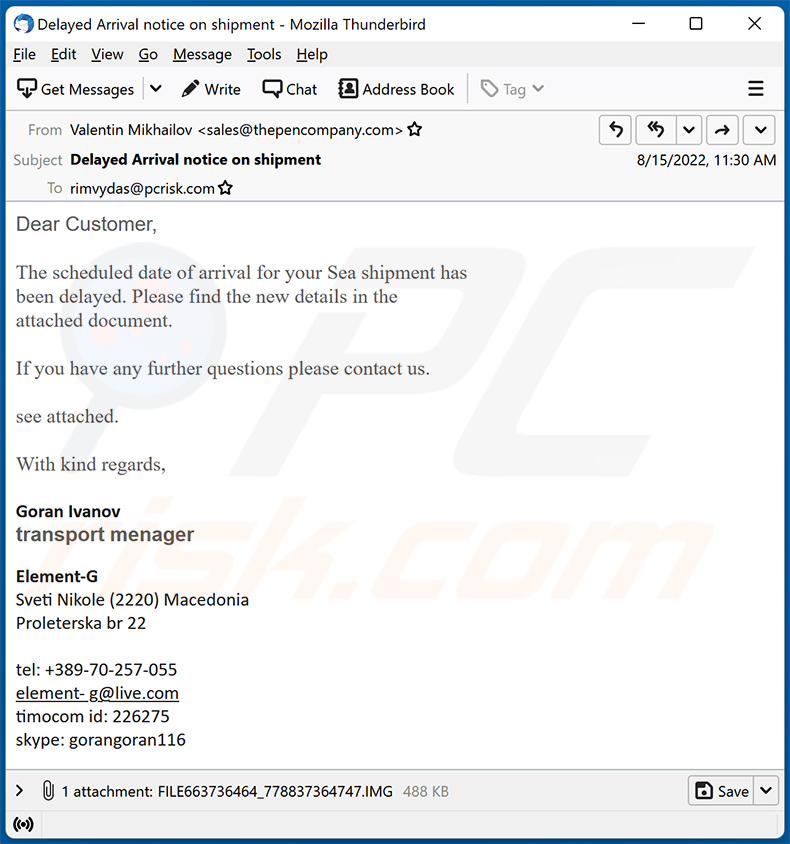
Text presented within:
Subject: Delayed Arrival notice on shipment
Dear Customer,
The scheduled date of arrival for your Sea shipment has
been delayed. Please find the new details in the
attached document.If you have any further questions please contact us.
see attached.
With kind regards,
Goran Ivanovtransport menager
Element-G
Sveti Nikole (2220) Macedonia
Proleterska br 22tel: +389-70-257-055
element- g@live.com
timocom id: 226275
skype: gorangoran116
Instant automatic malware removal:
Manual threat removal might be a lengthy and complicated process that requires advanced IT skills. Combo Cleaner is a professional automatic malware removal tool that is recommended to get rid of malware. Download it by clicking the button below:
DOWNLOAD Combo CleanerBy downloading any software listed on this website you agree to our Privacy Policy and Terms of Use. To use full-featured product, you have to purchase a license for Combo Cleaner. 7 days free trial available. Combo Cleaner is owned and operated by RCS LT, the parent company of PCRisk.com.
Quick menu:
- What is Arrival Notice spam?
- Types of malicious emails.
- How to spot a malicious email?
- What to do if you fell for an email scam?
Types of malicious emails:
![]() Phishing Emails
Phishing Emails
Most commonly, cybercriminals use deceptive emails to trick Internet users into giving away their sensitive private information, for example, login information for various online services, email accounts, or online banking information.
Such attacks are called phishing. In a phishing attack, cybercriminals usually send an email message with some popular service logo (for example, Microsoft, DHL, Amazon, Netflix), create urgency (wrong shipping address, expired password, etc.), and place a link which they hope their potential victims will click on.
After clicking the link presented in such email message, victims are redirected to a fake website that looks identical or extremely similar to the original one. Victims are then asked to enter their password, credit card details, or some other information that gets stolen by cybercriminals.
![]() Emails with Malicious Attachments
Emails with Malicious Attachments
Another popular attack vector is email spam with malicious attachments that infect users' computers with malware. Malicious attachments usually carry trojans that are capable of stealing passwords, banking information, and other sensitive information.
In such attacks, cybercriminals' main goal is to trick their potential victims into opening an infected email attachment. To achieve this goal, email messages usually talk about recently received invoices, faxes, or voice messages.
If a potential victim falls for the lure and opens the attachment, their computers get infected, and cybercriminals can collect a lot of sensitive information.
While it's a more complicated method to steal personal information (spam filters and antivirus programs usually detect such attempts), if successful, cybercriminals can get a much wider array of data and can collect information for a long period of time.
![]() Sextortion Emails
Sextortion Emails
This is a type of phishing. In this case, users receive an email claiming that a cybercriminal could access the webcam of the potential victim and has a video recording of one's masturbation.
To get rid of the video, victims are asked to pay a ransom (usually using Bitcoin or another cryptocurrency). Nevertheless, all of these claims are false - users who receive such emails should ignore and delete them.
How to spot a malicious email?
While cyber criminals try to make their lure emails look trustworthy, here are some things that you should look for when trying to spot a phishing email:
- Check the sender's ("from") email address: Hover your mouse over the "from" address and check if it's legitimate. For example, if you received an email from Microsoft, be sure to check if the email address is @microsoft.com and not something suspicious like @m1crosoft.com, @microsfot.com, @account-security-noreply.com, etc.
- Check for generic greetings: If the greeting in the email is "Dear user", "Dear @youremail.com", "Dear valued customer", this should raise suspiciousness. Most commonly, companies call you by your name. Lack of this information could signal a phishing attempt.
- Check the links in the email: Hover your mouse over the link presented in the email, if the link that appears seems suspicious, don't click it. For example, if you received an email from Microsoft and the link in the email shows that it will go to firebasestorage.googleapis.com/v0... you shouldn't trust it. It's best not to click any links in the emails but to visit the company website that sent you the email in the first place.
- Don't blindly trust email attachments: Most commonly, legitimate companies will ask you to log in to their website and to view any documents there; if you received an email with an attachment, it's a good idea to scan it with an antivirus application. Infected email attachments are a common attack vector used by cybercriminals.
To minimise the risk of opening phishing and malicious emails we recommend using Combo Cleaner Antivirus for Windows.
Example of a spam email:

What to do if you fell for an email scam?
- If you clicked on a link in a phishing email and entered your password - be sure to change your password as soon as possible. Usually, cybercriminals collect stolen credentials and then sell them to other groups that use them for malicious purposes. If you change your password in a timely manner, there's a chance that criminals won't have enough time to do any damage.
- If you entered your credit card information - contact your bank as soon as possible and explain the situation. There's a good chance that you will need to cancel your compromised credit card and get a new one.
- If you see any signs of identity theft - you should immediately contact the Federal Trade Commission. This institution will collect information about your situation and create a personal recovery plan.
- If you opened a malicious attachment - your computer is probably infected, you should scan it with a reputable antivirus application. For this purpose, we recommend using Combo Cleaner Antivirus for Windows.
- Help other Internet users - report phishing emails to Anti-Phishing Working Group, FBI’s Internet Crime Complaint Center, National Fraud Information Center and U.S. Department of Justice.
Share:

Tomas Meskauskas
Expert security researcher, professional malware analyst
I am passionate about computer security and technology. I have an experience of over 10 years working in various companies related to computer technical issue solving and Internet security. I have been working as an author and editor for pcrisk.com since 2010. Follow me on Twitter and LinkedIn to stay informed about the latest online security threats.
PCrisk security portal is brought by a company RCS LT.
Joined forces of security researchers help educate computer users about the latest online security threats. More information about the company RCS LT.
Our malware removal guides are free. However, if you want to support us you can send us a donation.
DonatePCrisk security portal is brought by a company RCS LT.
Joined forces of security researchers help educate computer users about the latest online security threats. More information about the company RCS LT.
Our malware removal guides are free. However, if you want to support us you can send us a donation.
Donate
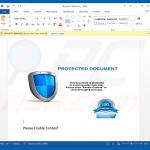
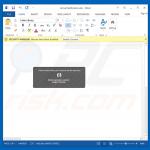
▼ Show Discussion